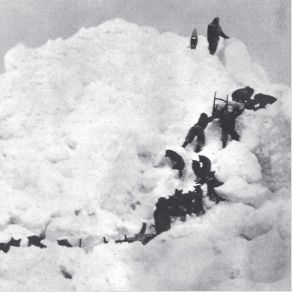Nunatak
Download links and information about Nunatak by Thomas Köner / Thomas Koner. This album was released in 1990 and it belongs to Electronica genres. It contains 11 tracks with total duration of 47:45 minutes.

|
|
|---|---|
| Artist: | Thomas Köner / Thomas Koner |
| Release date: | 1990 |
| Genre: | Electronica |
| Tracks: | 11 |
| Duration: | 47:45 |
| Buy it NOW at: | |
| Buy on iTunes $9.99 | |
| Buy on Amazon $8.99 | |
Tracks
[Edit]| No. | Title | Length |
|---|---|---|
| 1. | Untitled, Pt. 1 | 3:22 |
| 2. | Untitled, Pt. 2 | 6:02 |
| 3. | Untitled, Pt. 3 | 4:27 |
| 4. | Untitled, Pt. 4 | 5:21 |
| 5. | Untitled, Pt. 5 | 6:02 |
| 6. | Untitled, Pt. 6 | 3:28 |
| 7. | Untitled, Pt. 7 | 4:57 |
| 8. | Untitled, Pt. 8 | 3:24 |
| 9. | Untitled, Pt. 9 | 3:27 |
| 10. | Untitled, Pt. 10 | 3:11 |
| 11. | Untitled, Pt. 11 | 4:04 |
Details
[Edit]Another in the series of Koner's self-consciously chilled and mysterious albums created with the use of treated cymbals, Nunatak Gongamur truly pushes the bounds of not merely ambient music, but music in general. Consisting almost entirely of dark drones and bursts, separated into 11 separate untitled tracks but essentially one extended piece, Nunatak Gongamur takes as the source of its inspiration the ill-fated Scott expedition to the South Pole. Celebrated at the time as a glorious defeat in the war of man against nature, later investigation demonstrated Scott to be a charismatic but ultimately flawed leader, blinded in particular by some astoundingly incompetent judgments on his part. One of them, the use of ponies (plant-eating animals sent to a continent where their fodder didn't grow anywhere), is noted with the cover art. Koner's composition falls somewhere between a requiem for the loss and waste of the expedition and a haunting, extremely inhuman evocation of the endless snow and ice fields of Antarctica that the core members of the expedition struggled through and died in. The swathes of deep echo and occasional crumbling rhythm create an aura of paranoid fascination, at once weirdly soothing and increasing the nervous tension every chance it gets. When Koner adds variety to the music, the effect can almost be shocking — consider the sudden distorted whines on the third and fifth tracks, which with its slight echo treatment and the rumbling background moans could almost be a disturbing cry for help. Other times, tones barely lurk in the mix, only on the edge of hearing, like being caught in an endless cavern where something curious hides in the dim distance. The killer touch is the use of space throughout the album — silences of various lengths maintaining the air of mysterious threat.